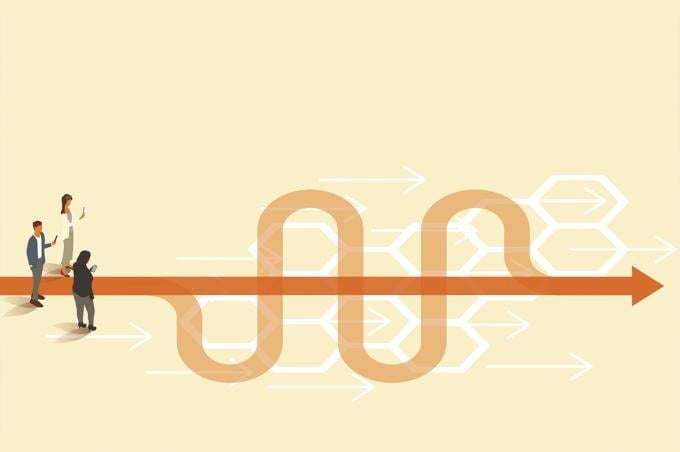No one wants to feel like just a cog in the machine at work, and physicians are no exception to the rule. The stakes, though, are somewhat higher in a profession where overwork and stress are contributing to a national burnout epidemic that affects not just physicians but their health systems, patients and society as a whole.
With almost half of physicians reporting at least one symptom of burnout, it’s incumbent upon organizations and leaders to find ways to show doctors they’re valued and important—a feeling that has proven to be protective against that very burnout.
As the leader in physician well-being, the AMA is reducing physician burnout by removing administrative burdens and providing real-world solutions to help doctors rediscover the Joy in Medicine™.
And while there is no overnight solution, health systems and other health care organizations can make specific, effective changes to create or recreate that joy in medicine. With that in mind, an AMA STEPS Forward® playbook offers five concrete strategies that leaders can employ to help physicians feel valued in an organization.
Find flexibility and autonomy
Physicians who feel as if they can control their work environment are more satisfied in their jobs. Though it’s impossible for physicians to choose every aspect of their workday, there must be some flexibility in the design of the schedule template, the daily or weekly work hours, their ability to work from home or other factors such as patient panel size. Also, physicians need to be paid for the significant amounts of work they do when they’re not directly seeing patients.
So, how can a balance be struck between a physician’s and an organization’s preferences?
“The common goal is that physician schedules allow patients to see their own physicians when they need to,” the playbook says, laying out strategies for introducing flexibility into scheduling. It also points out the need to plan for adequate time for managing patient panels and offers a sample approach for determining how much should be blocked off.
There’s a danger to giving physicians too many patients, and the playbook explains how that often happens. It also delves into what factors go into determining how many patients a physician can effectively handle, and how to handle schedules when it comes to onboarding doctors new to the organization.
Support time off
With studies showing that three out of every five physicians take 15 days or fewer vacation days a year, and one out of five takes five or fewer days, despite having an average of 25 to 35 days of PTO annually, there’s a disconnect.
Physicians need time off to unwind, relax, spend time with their loved ones and decompress from highly stressful and demanding jobs. Taking vacation time doesn’t just help them and their loved ones, though. Their health systems, coworkers and patients all benefit from the lower rates of burnout conferred by their physicians taking restful, adequate vacation.
There are three components to what the AMA calls “real PTO”—time during which patient care and EHR responsibilities are covered, time that plans for lead-in and catch-up duties and time that does not penalize the physician financially.
It’s also important to create a culture that encourages taking time off. The field of medicine rewards self-sacrifice and strong work ethic, and while that should not be dismantled, it should also not become a barrier to taking restorative PTO. The playbook offers strategies for creating a pro-PTO culture that includes preemptively blocking off PTO on physician schedules and refraining from praising physicians who work while they are supposed to be taking time off.
The playbook also lays out seven EHR inbox coverage models, giving the pros and cons for each method and explaining the impact on covering physicians and those taking PTO. Additionally, three models (for salary-based, RVU-based and alternative structures) are presented for how to let compensation support—not discourage—physicians taking PTO.
Keep a physician’s passions in mind
With studies showing that spending a fifth of one’s professional time on activities of interest can lessen and prevent burnout, finding ways to develop physicians is key to prioritizing their well-being.
There are many paths for physicians, and leaders can find ways to support them in entrepreneurship, clinical medicine and continuing education, research, teaching and medical education, health system administration and leadership, patient community engagement and professional community engagement.
The playbook suggests ways for an organization to help physicians pursue their passions and offers strategies for leaders looking to bring up professional development questions in formal or informal conversations with the physicians they lead.
Support physician resiliency
The language of self-care has entered our lexicon, seeming at times almost hollow with overuse. And while it’s true that no personal or organizational self-care efforts can make up for inadequate system-level support, it’s also important to aid physicians in developing individual resiliency.
There are several protective self-care measures included in the playbook, with suggestions for how both organizations and physicians can help achieve those goals. Among them are limiting distractions, decisions and commitments, prioritizing your to-do list, setting boundaries, taking breaks and connecting socially.
While the AMA believes that physicians can and should be asked credentialling questions about current conditions that hamper their ability to safely practice medicine, stigmatizing questions or those that dig into past or irrelevant experiences can discourage physicians from seeking mental health treatment. To help, the playbook offers ways to change these documents to reduce stigma and encourage physicians to get help when they need it.
Provide concrete help for trauma
By the very nature of their jobs, physicians will be exposed to traumatic events. They may have a patient who has an adverse outcome, be harmed physically while they are doing their jobs or experience collective trauma through events such as disease epidemics, terrorist attacks and mass shootings.
Organizations need to support physicians in their recoveries from these traumatic experiences through a variety of efforts including by creating peer-support networks, suicide prevention and response plans, confidential mental health services and a credentialling process that does not discourage them from getting help.
In the end, leaders and organizations need to find a way to reject the culture of overwork and underappreciation. They need to show physicians that their well-being is important—no, essential—to the mission.
AMA STEPS Forward® open-access resources offer innovative strategies that allow physicians and their teams to thrive in the new health care environment. These physician-developed resources can help you prevent burnout, create the organizational foundation for joy in medicine and improve practice efficiency.




